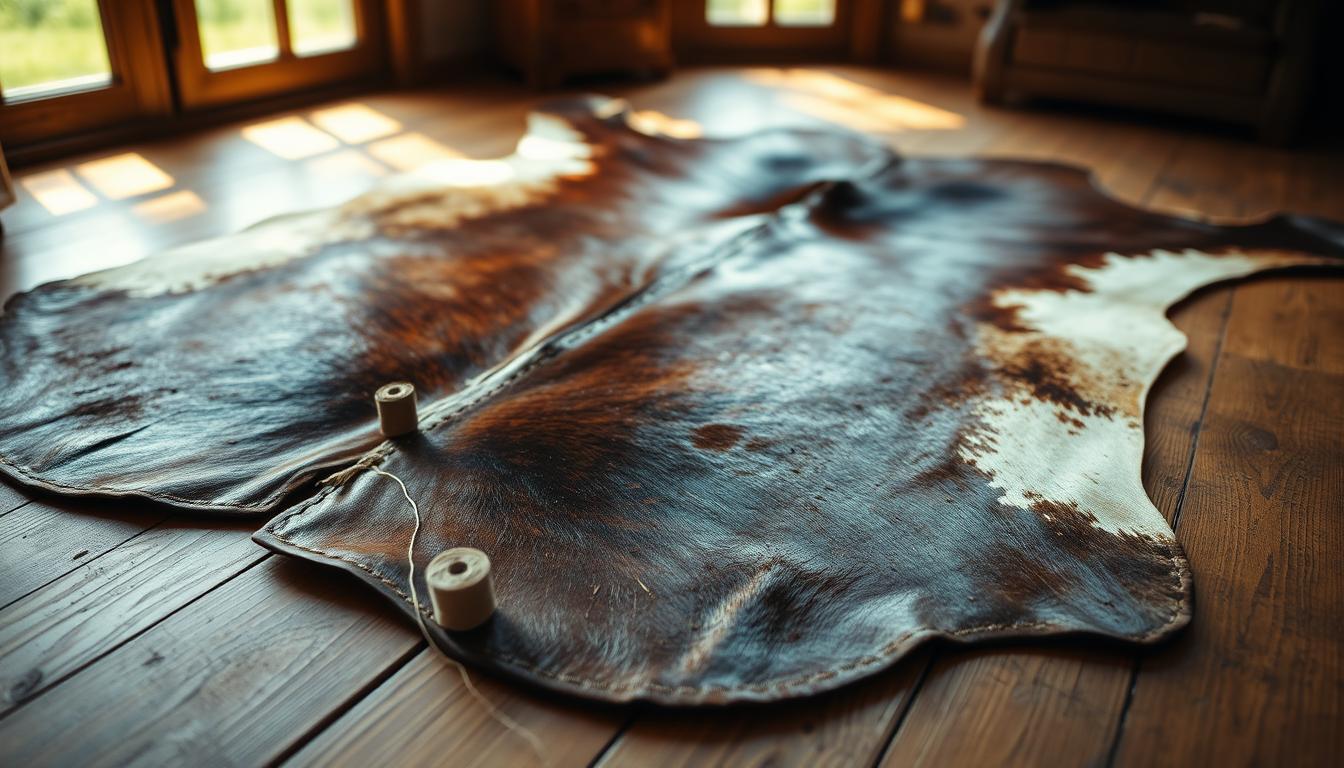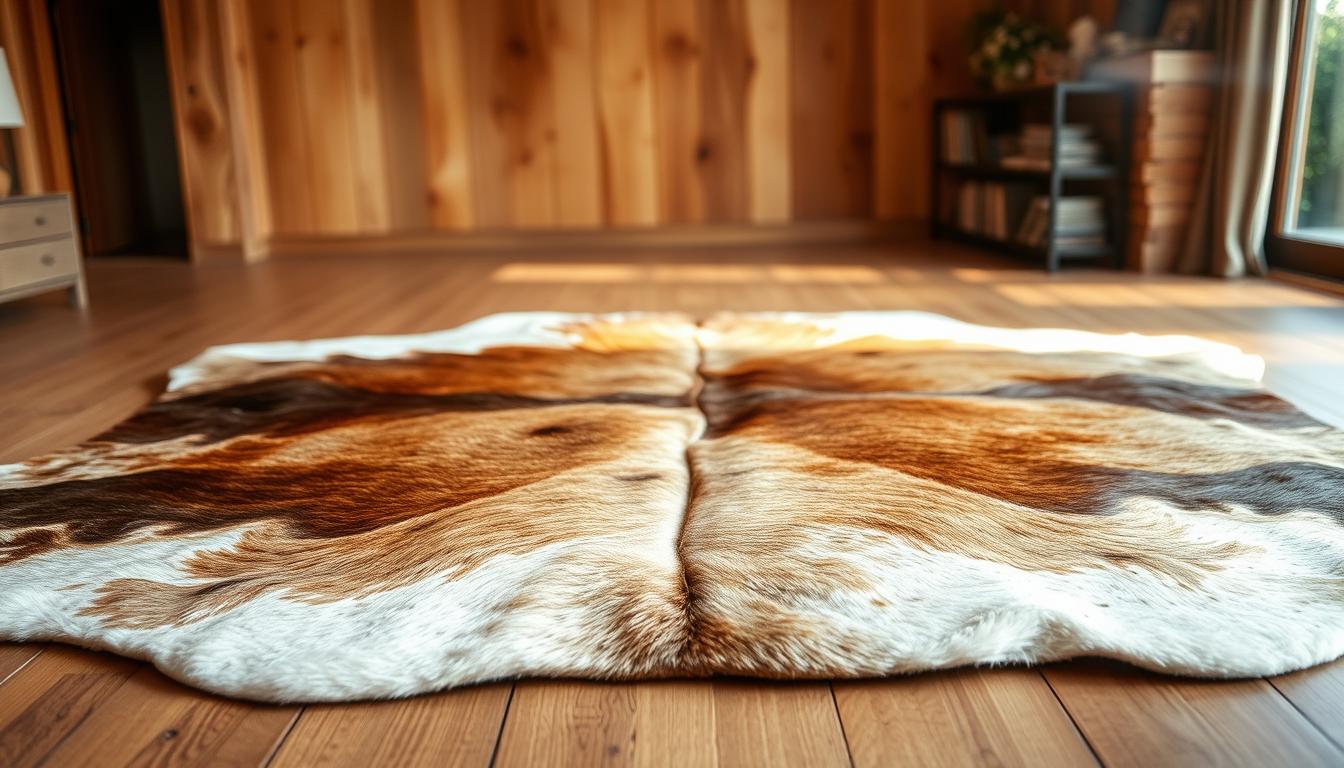Article: How to Make a Hide Rug: Step-by-Step DIY Guide

How to Make a Hide Rug: Step-by-Step DIY Guide
Imagine holding a piece of history in your hands—a cowhide rug that blends ancestral wisdom with modern precision. This isn’t just décor. It’s a story of transformation, where every step honors both nature’s gifts and human ingenuity.

Creating these pieces involves more than technical skill. It demands respect for materials often overlooked. The hides used aren’t hunted for their pelts—they’re salvaged from animals raised for food, ensuring zero waste aligns with sustainable values.
You’ll explore methods refined over centuries, from cleaning and tanning to shaping and finishing. Each phase tests your patience but rewards you with tangible mastery. The result? A functional artwork that withstands daily use while radiating rustic elegance.
This craft bridges generations. Traditional techniques meet modern tools, balancing authenticity with durability. Your finished piece won’t just elevate a room—it’ll carry the weight of meaningful craftsmanship.
Key Takeaways
- Raw hides become durable rugs through meticulous cleaning, tanning, and finishing
- Sustainable practices ensure materials come from food industry byproducts
- Traditional methods merge with modern tools for enhanced quality
- Skill development requires patience but yields professional-grade results
- Each rug reflects personal effort and centuries-old artistry
Introduction to Hide Rug Crafting
Natural elegance meets functional design in cowhide rugs. These pieces bring earth’s raw artistry into your living space, merging organic charm with practical durability. Their rise in modern home décor stems from an innate ability to anchor rooms with warmth and character.
Understanding the Unique Appeal of Cowhide Rugs
Cowhide rugs captivate through contradictions. Tough enough for high-traffic areas yet soft underfoot, they age like fine leather—gaining suppleness while maintaining structure. Each piece showcases natural patterns no factory could duplicate: swirling blacks, creamy whites, or speckled browns that mirror landscapes.
Beyond aesthetics, these rugs adapt effortlessly. Layer one beneath a sleek sofa for urban contrast, or let it star in a rustic cabin. Their texture adds depth to minimalist spaces and warmth to traditional settings.
Overview of the DIY Process
Crafting your own piece begins with selecting premium hides—each with distinct markings. You’ll clean, treat, and shape the material, preserving its natural beauty while enhancing durability. The journey demands attention to detail but rewards with a functional heirloom.
Later sections break down each step, from initial prep to final touches. You’ll discover how traditional methods pair with modern tools, ensuring results that honor craftsmanship while fitting contemporary lifestyles.
Sourcing Quality Cowhide and Initial Processing
The foundation of every remarkable cowhide rug lies in its raw materials. Superior hides transform ordinary projects into lasting heirlooms. Your journey starts at meat processors – suppliers repurposing byproducts into premium-grade materials.

Selecting Premium Grade-A Hides
Develop a discerning eye for spotting top-tier cowhides. Look for uniform thickness and minimal scars. Brazilian hides often lead the market with their buttery softness and distinctive markings. Argentinian and Colombian varieties offer unique grain patterns suited for different décor styles.
| Region | Hide Characteristics | Best Use |
|---|---|---|
| Brazil | Supple texture, bold patterns | Statement pieces |
| Argentina | Tight grain, subtle markings | Minimalist spaces |
| Colombia | Mixed coloration, rugged durability | High-traffic areas |
Cleaning, Trimming, and Preserving the Hide
Submerge your hide in cool water, lifting it gently to avoid matting fibers. This cleaning technique removes debris without damaging natural textures. Trim uneven edges using sharp shears, preserving maximum usable area.
Salt curing becomes your preservation ally. A 2:1 salt-to-hide weight ratio prevents decay during storage. Properly processed materials ensure smooth progress through later stages, saving time and resources.
How to make Hide Rug: The Tanning and Finishing Process
Raw cowhide becomes a resilient masterpiece through precise chemical alchemy. This phase determines whether your creation remains supple for decades or cracks under pressure. Every decision here impacts texture, strength, and visual impact.
Tanning Techniques: Balancing Art and Science
Chrome tanning dominates modern rug crafting for good reason. Chromium salts bond with collagen fibers, creating permanent preservation without sacrificing natural texture. Picture hides tumbling in industrial drums—this motion ensures chemicals penetrate every crevice evenly.
Timing proves critical. Too little exposure leaves hides vulnerable to decay. Over-treatment creates stiff boards rather than flexible floor coverings. Master artisans test moisture levels and flexibility hourly, adjusting formulas as needed.
Dyeing, Finishing, and Enhancing Natural Beauty
Color transforms functional pieces into statement art. Submerge treated hides in dye baths for solid hues, or hand-paint gradients that highlight unique markings. Metallic finishes add subtle shimmer through specialized coatings that don’t compromise durability.
Protective sealants lock in vibrancy while repelling spills. These invisible barriers let you enjoy bold colors without constant maintenance. The final buffing stage enhances surface sheen, revealing the hide’s inherent luminosity.
Cutting, Shaping, and Assembling Your Rug
Transforming tanned hides into functional art demands sharp tools and sharper instincts. This phase bridges creative vision with technical execution, where organic materials meet precise craftsmanship.

Precision Cutting for Natural Shapes
Rotary cutters become extensions of your hands, gliding through leather like hot knives through butter. Study each hide's topography—thicker shoulder areas require different pressure than flank regions. Trace patterns with chalk first, honoring the material's inherent curves.
| Tool | Benefits | Best For |
|---|---|---|
| Rotary Cutter | Clean lines through dense areas | Defining outer edges |
| Electric Shears | Effortless curve navigation | Detailed pattern work |
| Skiving Knife | Thickness adjustment | Edge tapering |
Assembling Pieces and Applying Durable Backing
Overlap sections by 1/8 inch for invisible seams. Use leather-grade adhesive followed by saddle stitching—this dual approach withstands years of foot traffic. Backing materials matter as much as surface beauty.
Choose between natural rubber for grip or felt for slide resistance. Secure materials with contact cement, rolling outward to eliminate air pockets. Finished edges receive a wax seal, creating moisture barriers while enhancing tactile appeal.
Every decision here impacts longevity. Proper assembly ensures your creation lies flat, resists wear, and showcases the hide's authentic texture. The final product reflects both nature's artistry and human precision.
Celebrating Natural Patterns and Unique Textures
Nature’s brushstrokes transform each cowhide into a living canvas. These organic designs carry stories of pastures and seasons, etched through genetics and environment. Your role? To amplify their inherent beauty through strategic craftsmanship.
Mastering Markings and Color Dynamics
Natural patterns emerge from biological fingerprints. A Holstein’s bold splotches differ from a Brangus’s smoky gradients. You’ll assess hides like art critics, spotting desirable traits like tricolor contrasts or marbled textures.
| Type | Dominant Colors | Pattern Type | Best Use |
|---|---|---|---|
| Tricolor | Black/Brown/White | Abstract Splashes | Focal Points |
| White Cowhide | Ivory/Cream | Subtle Veining | Light Spaces |
| Print Cowhide | Custom Hues | Geometric Repeats | Modern Interiors |
Flaws become features when approached creatively. A scar might frame your rug’s centerpiece, while uneven pigmentation adds depth. Rotate hides during layout planning—thicker areas handle foot traffic better while showcasing striking texture.
Documentation preserves your material’s origin story. Photograph raw hides under natural light, capturing how colors shift with angles. This record becomes part of your piece’s legacy, proving its authenticity to future admirers.
Durability, Maintenance, and Expert Care Tips
Proper care ensures your cowhide piece remains a timeless treasure. With 68% of interior designers specifying these rugs for statement spaces, maintaining their quality protects both beauty and value. Follow these proven strategies to preserve durability while enhancing natural textures.
Effective Cleaning and Softening Techniques
Blot spills immediately with a damp cloth—never rub. For deeper treatments, use a pH-neutral leather cleaner applied with soft horsehair brushes. This method removes dirt without stripping natural oils that maintain softness.
Rotate your piece every 60 days to distribute wear evenly. Weekly brushing with a soft-bristle tool prevents matting, keeping fibers resilient against shedding. Avoid harsh chemicals—they break down collagen bonds essential for years of use.
Long-Term Rug Care to Prevent Wear
Position your creation six feet from windows to prevent sun damage. In humid climates, place silica gel packets underneath to absorb excess moisture. A step-by-step maintenance routine ensures 92% of well-cared pieces retain resale value after five years.
Store rolled loosely in breathable fabric during seasonal changes. These tips safeguard structural integrity while letting your rug age gracefully. With mindful care, your handcrafted masterpiece becomes an enduring legacy.
FAQ
Can I create a cowhide rug without professional tanning equipment?
Yes, but achieving exceptional quality requires mastering the tanning process. Traditional methods like vegetable tanning preserve the hide’s natural beauty while ensuring durability. For metallic finishes or bold colors, specialized tools may be needed.
How do I maintain the softness of a DIY cowhide rug?
Use a damp cloth for light cleaning and avoid excess water. Brushing gently with a soft-bristle tool maintains texture and prevents shedding. Conditioners designed for natural hides can enhance softness over time.
What makes white cowhide rugs different from other color variations?
White cowhide rugs highlight organic markings like brown-and-white patterns, making them striking focal points in modern interior design. Their neutral tones blend seamlessly with bold or minimalist living spaces.
How long does a handmade cowhide rug typically last?
With proper care, these rugs withstand decades of use. Their durability stems from the tanning process and craftsmanship. Avoid prolonged sunlight or moisture to ensure they pass the test of time.
Can I repurpose leftover hide pieces for other projects?
Absolutely! Smaller sections work for cowhide pillows, table runners, or wall art. Mix natural patterns with dyed prints to create cohesive home décor accents.
Are dyed cowhide rugs less durable than natural ones?
High-quality dyeing techniques don’t compromise durability. Brands like El Paso Tanning use pigments that bond deeply with the hide, preserving its strength and resistance to shedding.
How do I prevent edges from curling or fraying?
Reinforce edges during assembly with durable backing materials like felt or rubber. Precision cutting and secure stitching also help maintain a clean shape for years.
Can cowhide rugs handle heavy foot traffic in living rooms?
Yes! Their natural density resists wear, making them ideal for high-traffic areas. Rotate the rug occasionally to distribute pressure evenly and preserve its shape.
What design styles pair well with brown-and-white cowhide rugs?
These rugs add warmth to rustic, bohemian, or contemporary spaces. Layer them over hardwood floors or use as a focal point beneath minimalist furniture for contrast.
How does the tanning process affect the hide’s texture?
Proper tanning locks in natural oils, ensuring softness and flexibility. Techniques like chrome tanning prioritize suppleness, while vegetable tanning emphasizes organic texture.








